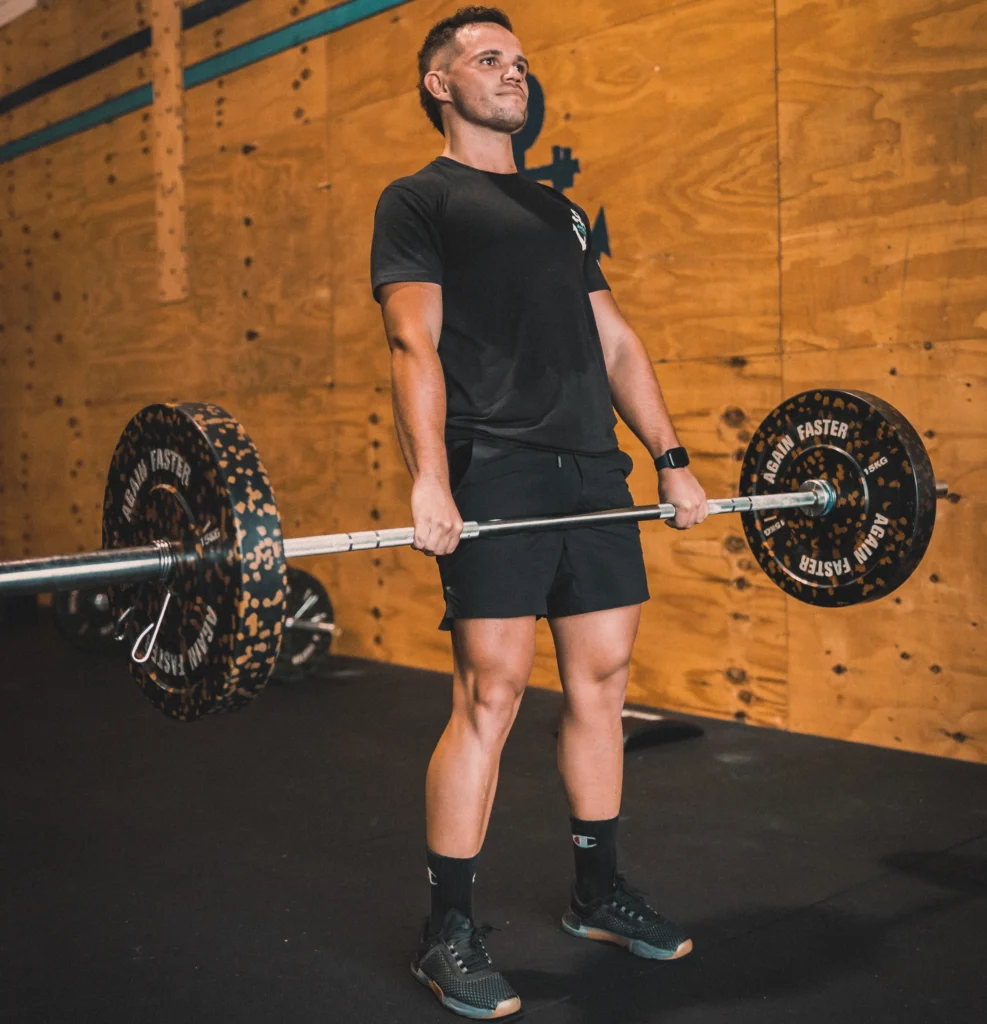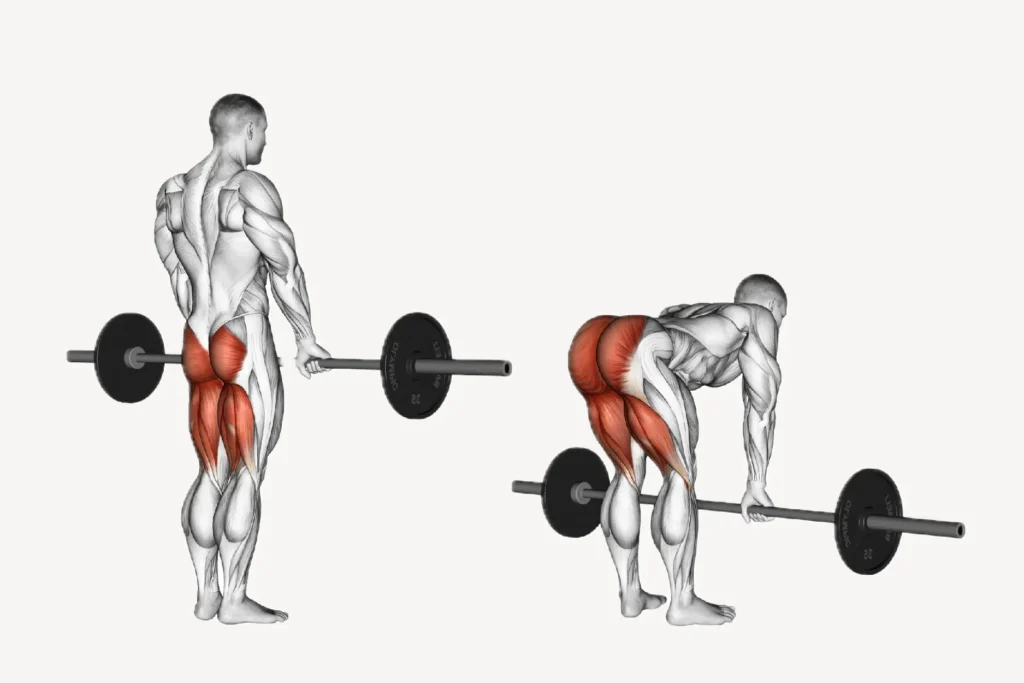When it comes to strength training exercises that target the posterior chain, the Stiff Leg Deadlift stands out as an effective and challenging option. In this comprehensive guide, we’ll delve deeper into the Stiff Leg Deadlift, exploring how to perform it correctly, its numerous benefits, essential do’s and don’ts and even the advantages of using specialized deadlift shoes.

Understanding Stiff Leg Deadlift
Before we dive into the specifics, let’s get a clear picture of what the stiff leg deadlift entails.
What is Stiff Leg Deadlift?
It is a compound exercise that primarily targets the muscles in your hamstrings, glutes, lower back and even your calves. This exercise is particularly effective at isolating the posterior chain, making it an excellent choice for developing strength and muscularity in these areas.
How to Perform Stiff Leg Deadlift
Now, let’s break down the step-by-step process for performing it correctly:
Step 1: Set Up
- As you stand, be sure your toes are pointed forward and your feet are hip-width apart.
- Position a barbell in front of you, loaded with an appropriate weight based on your fitness level.
- Bend at your hips to reach the barbell. Keep your back straight, chest up and maintain a slight bend in your knees (nearly straight).
Step 2: The Descent
- Begin the descent by pushing your hips back while keeping your back straight. Imagine sticking your buttocks out as if closing a door with them.
- Lower the barbell while maintaining a strong core and keeping it close to your body. Your knees should have a slight bend throughout this phase.
- Lower the barbell until you feel a comfortable stretch in your hamstrings. Ensure your back remains straight throughout the descent.
Step 3: The Ascent
- To return to the starting position, push through your heels and extend your hips. This motion should bring you back up to a standing position.
- As you ascend, engage your glutes and hamstrings to lift the barbell while maintaining a straight back.
- Complete the repetition by standing tall with your hips fully extended, maintaining good posture.
Stiff Leg Deadlift Benefits

Performing this deadlift offers a myriad of benefits for both novice and experienced lifters:
1. Enhanced Hamstring and Glute Development: The stiff leg deadlift places significant emphasis on the hamstrings and glutes, making it an ideal exercise for strengthening and toning these muscle groups.
2. Improved Posture and Lower Back Strength: As you engage your lower back muscles throughout the exercise, it helps improve posture and lower back strength. This can be especially beneficial if you have a sedentary job that involves prolonged sitting.
3. Functional Strength: This compound movement mimics real-world activities like lifting heavy objects, making it a functional exercise that can improve your daily life.
4. Muscular Symmetry: This deadlift help address muscular imbalances by targeting specific muscle groups in the posterior chain.
5. Increased Grip Strength: Holding onto heavy weights during this Deadlift also contributes to enhanced grip strength.
6. Caloric Expenditure: Like all compound exercises, it burns a significant number of calories, aiding in weight management.
Do’s and Don’ts
To ensure safety and effectiveness, keep these essential do’s and don’ts in mind:
DO:
- Warm Up: Prioritize a thorough warm-up to prepare your muscles and joints for the exercise.
- Start with Light Weights: If you’re new to this deadlift, begin with lighter weights to perfect your form before progressing to heavier loads.
- Engage Your Core: Maintain a tight core throughout the movement to support your spine.
- Use Proper Form: Pay close attention to your form, keeping your back straight and knees slightly bent.
- Breathe Correctly: Exhale as you lift the weight and inhale as you lower it, coordinating your breath with the movement.
DONT:
- Round Your Back: Avoid rounding your back at any point during the exercise to prevent potential injury.
- Neglect Progression: Gradually increase the weight you lift to avoid overexertion and maintain safe progression.
- Rush Through Repetitions: Perform each repetition with control and intention, avoiding any jerky or rushed movements.
- Overdo It: Be cautious not to overtrain. Allow enough time between sessions for relaxation and recovery.
The Advantages of Deadlift Shoes

While the focus here is on the Stiff Leg Deadlift, it’s worth mentioning the advantages of using specialized deadlift shoes. These shoes are designed to optimize your performance during deadlift exercises, including this deadlift.
1. Improved Stability: Deadlift shoes typically have flat, non-compressible soles that enhance stability, allowing you to maintain proper form and balance during lifts.
2. Reduced Range of Motion: The minimal sole thickness of deadlift shoes minimizes the distance the barbell must travel, potentially allowing you to lift more weight more efficiently.
3. Enhanced Grip: These shoes often feature enhanced grip patterns on the soles, ensuring your feet stay firmly planted during the lift.
4. Ankle Support: Some deadlift shoes provide additional ankle support, which can be advantageous for individuals with mobility or stability concerns.
5. Increased Confidence: The combination of improved stability and grip can boost your confidence when lifting heavy weights.
In Conclusion

The Stiff Leg Deadlift is a remarkable exercise for developing strength, muscle tone and overall fitness. When performed correctly and with attention to proper form, it can be a valuable addition to your workout routine. Remember to start with lighter weights, prioritize your warm-up, and engage your core throughout the exercise.
While deadlift shoes are not mandatory, they can undoubtedly enhance your performance and provide added stability during deadlift. Their flat soles, grip patterns and ankle support make them a worthwhile consideration for serious lifters.
Lastly, always listen to your body and progress at your own pace. Incorporate Stiff Leg Deadlift into your routine consistently but responsibly. As you master this exercise, you’ll reap the numerous benefits it offers, from improved strength and posture to enhanced muscular symmetry and beyond.
So, equip yourself with the knowledge and gear you need, get to the gym and start incorporating it into your fitness regimen. Your posterior chain will thank you, and you’ll be well on your way to achieving your health and fitness goals.
FAQs
Are stiff leg deadlift suitable for beginners?
It can be suitable for beginners, but it’s crucial to start with light weights and focus on perfecting your form before progressing to heavier loads.
How often should I incorporate stiff leg deadlift into my routine?
The frequency of this deadlift depends on your overall workout routine. As a general guideline, aim to include them in your leg or full-body workouts once or twice a week.
Can stiff leg deadlift replace conventional deadlifts?
While stiff leg deadlift are excellent for targeting specific muscle groups, they should not entirely replace conventional deadlifts, which offer a more comprehensive full-body workout.
What should I do if I experience lower back discomfort while performing stiff leg deadlift?
If you experience lower back discomfort, it’s essential to reassess your form. Ensure your back remains straight throughout the exercise, and consider reducing the weight until your form improves.
Are deadlift shoes necessary for stiff leg deadlift?
Deadlift shoes are not necessary for stiff leg deadlift, but they can provide added stability and benefits. You can perform deadlift in flat-soled training shoes or even barefoot if you prefer. However, for those who are serious about their strength training and want to optimize their performance in exercises like the stiff leg deadlift, investing in deadlift shoes is worth considering.
What’s the difference between stiff leg deadlift and Romanian deadlift?
Stiff leg deadlift and Romanian deadlift are often used interchangeably, but there is a subtle difference. While both exercises target the posterior chain, typically involve a more Romanian deadlift pronounced knee bend, while stiff leg deadlift emphasize keeping the legs almost straight throughout the movement.
Can I use lifting straps for stiff leg deadlift?
Lifting straps can be used for this deadlift to improve grip on the barbell, especially when lifting heavier weights. However, it’s advisable to initially work on grip strength without straps to maintain overall hand and forearm strength.